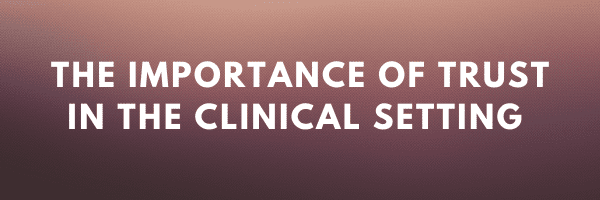Gaining trust
One factor in clinical practice that really isn’t given enough emphasis in training is TRUST.
We focus heavily on the clinical sciences, critical decision making, treatment planning and delivery, but it can be too easy for the patient to be “left behind” in it all.
It doesn’t take much digging to find research papers on the importance of communication in the therapeutic relationship, or the value of contextual factors, environment, rapport and expectations.
Feel free to hit the Communication folder in our free Research Library HERE.
As clinicians, it should be our primary goal when we first connect with a new patient, to build trust. Without that we are unlikely to get the outcomes we and the patient seek.
But what does that process look like?
Here are a few steps that should be considered…
Recognise that the patient has come to you as an “expert”, so don’t be afraid to demonstrate that you know what you are talking about.
None of us want to gloat, but your patient will gain a lot of confidence if they hear that you understand their presentation, have worked with it previously, and typically get excellent results. Don’t be backward in telling them YOU KNOW YOUR STUFF!
Take control. Lead them confidently through the assessment process and explain what and WHY you are doing each thing. The WHY part is so powerful, for two reasons. Firstly because it helps them understand the value of what you are doing, but secondly is demonstrates that they are in the hands of someone who knows what it will take to get them the results they want.
Deliver it with confidence! Provide all your explanations with direct eye contact, speak slowly and clearly, and look for acknowledgement from them throughout.
A strong and confident explanation is powerful.
Employ empathy. Make it obvious that you understand the difficulties they may face with compliance with your treatment plan, both from a money and time perspective. Also make it obvious that you recognise that their pain has a big impact on their life. Acknowledge that, but don’t imply that it should be used as an excuse. Your patient will respect your ability to see things from their perspective, but they will also appreciate and respect a “this is the way it is” attitude from you. Be caring, but be clear that there are things they need to do if they are going to get the outcomes they seek.
It’s tricky work this clinical practice stuff, isn’t it?
Not only do we have to wear the analytical hat to solve detailed problems, and the technician hat as we provide high level skills to produce outcomes, but we also have to wear the leadership hat as we deal with the complexities of our patient’s mind and all the layers that come with that.
Got a great story or example of how you’ve succeeded (or perhaps struggled) with this? I’d love for you to share it with me. Hit THIS LINK and tell me all about it.
Your’s in health,
Shaun Brewster.




